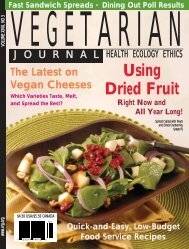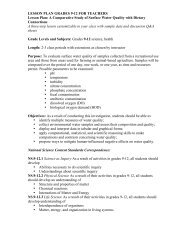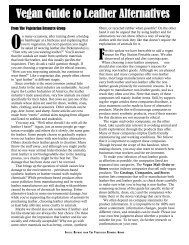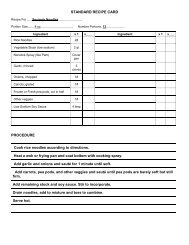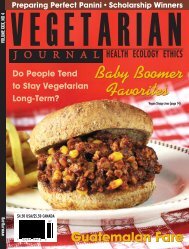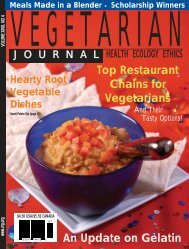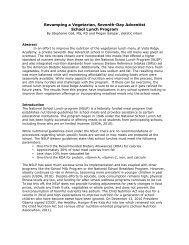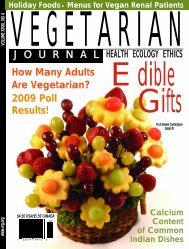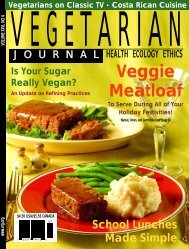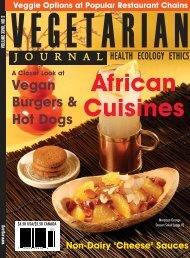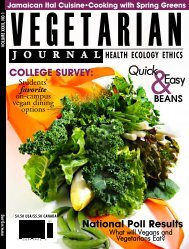Southwestern - The Vegetarian Resource Group
Southwestern - The Vegetarian Resource Group
Southwestern - The Vegetarian Resource Group
- No tags were found...
Create successful ePaper yourself
Turn your PDF publications into a flip-book with our unique Google optimized e-Paper software.
Foodservice UpdateHealthy Tips and Recipes for Institutions from <strong>The</strong> <strong>Vegetarian</strong> <strong>Resource</strong> <strong>Group</strong>Texture Alterations for Vegan DietsBy Chef Nancy Berkoff, RD, EdDPATIENTS AND CLIENTS MAY EXPERIENCE A NUMBERof physical, mental, and dental conditions thatwill require specially prepared meals. <strong>The</strong>re aremany different types of issues that may interfere withsomeone’s ability to consume foods. For example, somepeople may be able to use a straw, others may forget tochew and swallow properly, and still others may coughfrequently throughout a meal, interfering with swallowing.Each requires slightly different textural alterations.If you know or work with clients or patients whosediets require texturally altered foods, this article willprovide you with some good tips to ensure that theyare receiving a complete and nutritionally balanced diet.GENERAL TIPS ABOUT PREPARINGTEXTURALLY ALTERED FOODSMaintaining patient interest and pride while servingthem texturally altered foods is paramount. <strong>The</strong>refore,you should try to serve altered ‘regular’ foods ratherthan relegating patients with textural alterations toa monotonous diet of applesauce, mashed potatoes,and broth. Keep texturally altered foods as close to the‘regular’ menu as possible. If everyone else is havingcarrots with parsley as a side dish, texturally alteredmenus should have them as well. Choosing a varietyof foods will provide adequate nutrients as well asprevent boredom for the patients.Many foods can be puréed without losing the flavor.However, you’ll need to use some imagination in servingthem so they look attractive. After all, no one wantsthree or four bowls of ‘mush’ served to them, no matterhow pleasant the color or aroma. For example, veganmeatballs and spaghetti can be chopped and servedover puréed spinach. <strong>The</strong>y may also be puréed andserved over garlic bread. Even if the bread cannot beeaten, it will add an attractive look and aroma. In addition,apple pie—crust and all—can be puréed and thenserved with a scoop of non-dairy ice cream as a dessert.SUGGESTIONS FOR FOODS THAT WORKWELL FOR TEXTURE ALTERATIONSMany vegan foods work well for texturally altered diets.No texture changes are needed for applesauce, mashedpotatoes, vegan refried beans (thinned with a bit oftomato juice, if needed), or hummus. Other veganfoods are easily altered for chopped or puréed diets.Try to serve altered ‘regular’ foodsrather than relegating patientswith textural alterations to amonotonous diet of applesauce,mashed potatoes, and broth.For example, most vegan soups, cooked beans, butternutor banana squash, cooked root vegetables (such asbeets, rutabagas, and carrots), or potatoes (includingwhite, yellow, sweet, and purple) can be run througha blender or food mill to create a hearty, correctlytexturedbase for a chopped or puréed meal.Lentil loaf, vegetarian pâté, and pasta casserolesmay be soft enough for chopped diets, and these canbe puréed for people who require even softer textures.In our kitchen, we prepare these entrées as we wouldfor customers who don’t have chewing or swallowingPlease Note: This article does not provide medical advice. It is very important for patients with chewing and swallowingproblems to work with a health care professional to meet their nutritional needs.18 Issue Two 2009 VEGETARIAN JOURNAL



